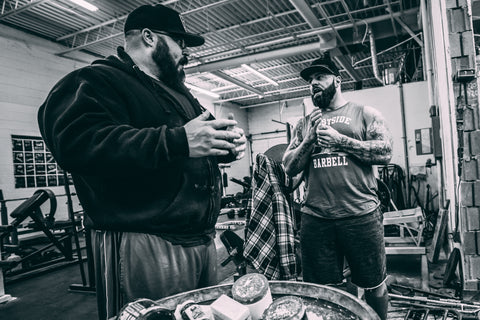The Almighty Barbell Row

In strength sports, when you think of muscle groups most responsible for producing tremendous amounts of strength, none rank higher than the muscles that make up the back. Back strength is paramount to the strength training process. Without a strong back, you will lack the ability to adequately brace and maintain optimal spinal posture, reducing your ability to display maximal strength and speed.
As a strength athlete, you should prioritize addressing your back strength as frequently as possible. At Westside, we include at least one back-focused accessory exercise each workout, often more. Why? Because it doesn’t matter if we are squatting, benching, or deadlifting, significant demand is placed upon the back.
The barbell row, and its many variations, are some of the best ways to develop the strength and size of the back muscles. What makes the barbell row valuable is that it is an exercise with many variations that can be applied to any training day. It’s safe to say, any lifter who considers themselves strong will likely perform at least 2-3 different row variations each week.
Here are a few of the common barbell row variations we use at Westside Barbell:
Bodybuilding Barbell Row
A bodybuilding barbell row is the barbell row everyone thinks of when they think of this exercise. To perform this exercise correctly, you will have a slight bend at the knee while maintaining a chest-up position to keep the spine properly braced.
An ideal bodybuilding barbell row position would be similar to your position when the bar is at mid-shin or lower knee level in a conventional deadlift. You want to row the barbell to your mid or lower abdominals and control the barbell as it descends.
The goal of this exercise is time under tension and specific targeting of the mid and upper back muscles. Wearing a belt will help brace the lumbar spine and allow a lifter to focus more on the mid and upper-back-specific work.
Suggested Sets: 3-5
Suggested Reps: 10-15
Frequency: 2-4x's per week (upper or lower training days)
Powerlifting Barbell Row
A powerlifting barbell row is a barbell row where the focus is placed more on the weight on the bar and a bit less on strict form. Many in the strength training community may have just fainted after reading that, but sometimes weight on the bar matters more than absolutely strict form does in the quest for strength (a quest many of these masters of movement are unfamiliar with).
I am not advocating placing your spine in danger by overloading the bar using a weight you know you have no business lifting while moving like you just learned to walk. The idea is to use a bit more weight than you could perform a strict bodybuilding-style row with and use some added body movement to get the barbell moving.
When performed correctly, you should rip the barbell as dynamically as possible to your upper abdominal area, controlling the descent of the barbell as much as possible for each rep. It is recommended to wear a belt; this will allow you to brace your trunk enough to protect the lumbar spine from injury when performing this exercise.
It is recommended to build up to this exercise, performing bodybuilding-style rows until you build strength and understand the movement. However, once you are prepared, there will be no better barbell row exercise in your arsenal to build back strength the way a powerlifting-style barbell row will. Westside has the 800lb and 900lb deadlifts to prove it.
Suggested Sets: 3-5
Suggested Reps: 5-8
Frequency: 2x’s per week (lower training days)
Pendlay Row
An exercise made popular by USA Weightlifting Coach Glen Pendlay; the Pendlay row is a great option to add variation to your barbell rows. We have found this lift to be a great benefit to the mid and upper back in the bench press and in building the strength necessary to maintain an ideal bar path in the deadlift.
A common cause of deadlift failure is a lifter being in a “chest over the bar” position. This position places the legs and glutes near full extension, placing a tremendous load on the lumbar spine and back muscles, causing the lifter to fail. This lift trains that position specifically and develops strength in those ranges.
You’ll realize the benefits of Pendlay Rows the next time you get out of position off of the floor with a deadlift and have the strength to regain posture and re-establish optimal bar path quickly. Additionally, you will strengthen the muscles of the upper and mid back, as well as the trunk.
Suggested Sets: 3-5
Suggested Reps: 8-10
Frequency: 2x’s per week (lower training days)
Build Your Back to Build Your Total
One thing Lou always hammered into our brains was the idea that your back can never be strong enough. The muscles that make up your back and trunk play the most crucial role in strength production; they protect and support your spine. Barbell rows rapidly build these muscles.
If you want to be able to exert tremendous amounts of absolute strength and power, you must have the ability to maintain proper spine posture throughout the entirety of a lift. It’s like a garden hose and water; once the spine starts to "bend", the nerve signal is reduced, and your ability to produce strength is severely limited.
A weak back is one of the most common reasons lifters fail a lift or injure themselves. Many fear training their back correctly due to misinformation spread by inexperienced individuals. At Westside, we constantly perform heavy good mornings and barbell rows, all while maintaining a low injury rate.
Don’t let a weak-minded coach scare you from training your back; train your back frequently and with heavy weights.
Sources:
Simmons, L. (2007). Westside Barbell Book of Methods. Westside Barbell.
Verkhoshansky, Y., & Siff, M. C. (2009). Supertraining. Verkhoshansky.





